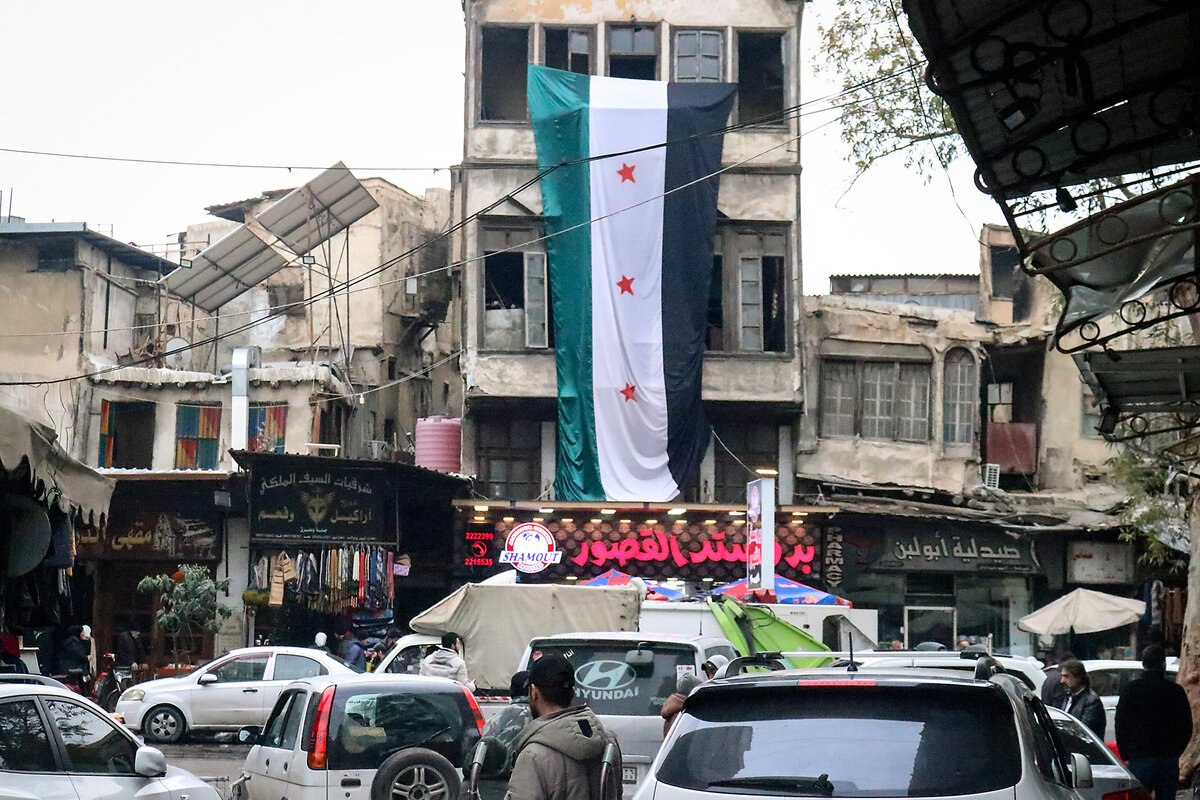Syria’s new flag is everywhere: ‘Everyone wants to touch freedom’
Loading...
| Damascus, Syria
With scarves and capes, caps and pendants, Syrians everywhere are wrapping themselves up in the new national colors.
After years of being illegal in much of the country, the “free Syria” flag – a green-white-black tricolor banner adorned with three red stars – flies in Damascus.
Yet the new flag is more than a national symbol. Syrians say what was for years the opposition flag is now an embodiment of the hardships of the revolution and the joy of their newfound freedoms.
Why We Wrote This
A story focused onSyrians rally around their old/new flag, a symbol of pride, hope, and freedom that rode into Damascus with the rebels who overthrew the Assad regime in December. It adorns everything.
“A free homeland,” says Mohammed Hassan, holding up a Syrian flag upon his arrival at Damascus International Airport from Qatar in late February, 10 years after being driven out by war. “This flag means we have finally returned and our country has returned to us.”
The opposition flag was swiftly adopted as the new national flag when rebels ousted Bashar al-Assad from power in December.
In today’s Syria, you can find it everywhere: draped on buildings, pinned to cars’ rear windows, in restaurant windows, spray-painted on the walls of Mr. Assad’s former palace, for sale at the airport’s duty-free shops.
But these are not just trinkets hawked by savvy Syrian merchants cashing in on a revolution. They are a response to legitimate popular demand.
At Umayyed Square in the capital, a dozen vendors sell Syrian flags and scarves to passing motorists. Others offer visitors a chance to have a photo of their family taken under a giant new Syria flag.
Expat Syrians Mohamed Abdul Wahab, his brother Omar, and a friend are euphoric to be back in Damascus, having arrived the night before from their current home in Istanbul. Their first stop the next morning was to be photographed under the flag at the famous square.
“We lost lives, left our homes, and made so many sacrifices just for the freedom to lift up this flag,” says Mr. Abdul Wahab as he purchases a flag scarf from a vendor. “To stand here, free and with this flag, is a dream come true.”
The new Syrian flag is the 1932 independence flag raised by Syrians under French colonial occupation. The tricolor has horizontal stripes of green, white, and black, with three red stars down the center stripe, which in the 1930s represented the three main states of Aleppo, Damascus, and Deir Ezzor.
The independence flag is itself a reimagining of the 1918 red, white, black, and green flag of the Great Arab Revolt, which rode in and liberated Damascus after a series of battles against the Ottomans throughout what is now Jordan and Syria.
After seizing power in a 1963 coup, the Baath Party imposed a flag that came to symbolize the Assad regime that began with Bashar’s father, Hafez al-Assad: red and black borders, with a white stripe in the middle and two green stars.
For many Syrians, the Baathist-Assad flag was a flag of fear.
During the 2011 Arab Spring, protesters across Syria demanding democracy and freedom resurrected the independence flag, waving it as they faced regime bullets.
The banner was used by the opposition and later rebels as they battled the regime in a brutal civil war. Its colors were raised in towns and villages under rebel control and at embassies in countries that recognized the Syrian opposition.
Now in Damascus, in what was once an Assad stronghold, printers regularly crank out thousands of flags.
At the Hadara bookshop in the Hamadiyya Souk, customers pick out flags of all lengths and sizes.
“Give me a flag with the words ‘freedom’ on it,” says Ahmed, a 20-year-old university student, after browsing the merchandise.
Bookshop owner Amer al-Halabi says he sold 10,000 flags in the first month after Bashar al-Assad’s Dec. 8 overthrow. Now he sells a few thousand flags and flag scarves per month to Syrian returnees and expats visiting after years of exile.
“The flag is a symbol of dignity, independence, and freedom that everyone wants to come and experience themselves,” he says. “Everyone wants to touch freedom.”
Mr. Abdul Wahab, the visitor from Istanbul, agrees.
“A flag tells the story of a people,” he says. “After so many hardships, our story ends in freedom.”







